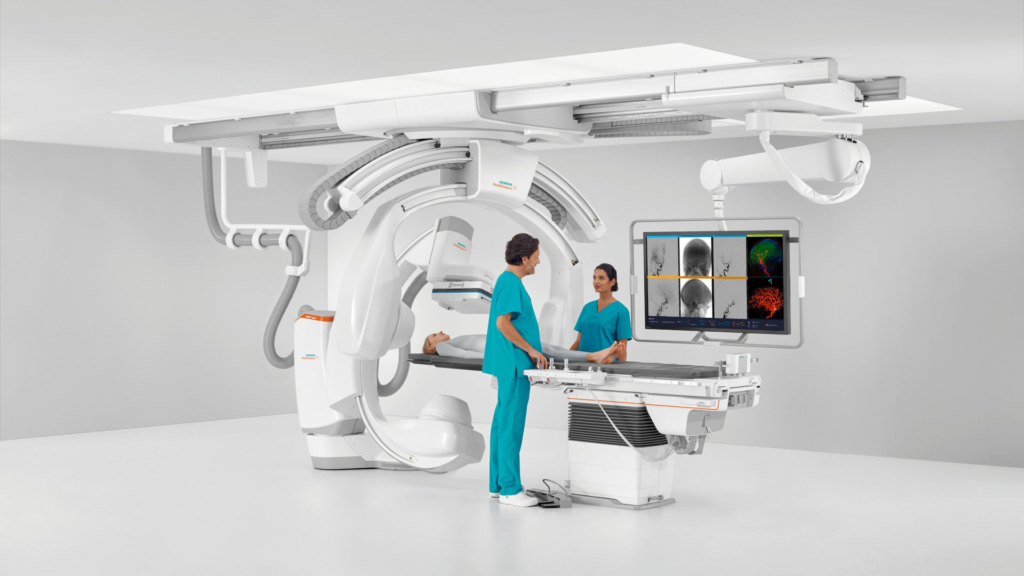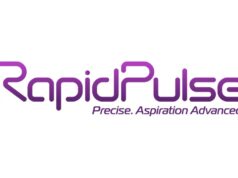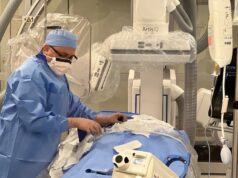
At the European Congress of Radiology (ECR; 27 February–3 March, Vienna, Austria) Siemens Healthineers will introduce the Artis icono biplane, an angiography system with special functions for neuroradiology.
An integral feature of this new system is its significantly improved 2D and 3D imaging, improving image quality and reducing the radiation dose required. As the C-arm can now perform new movement patterns, the areas of the cranial base and skull cap can now be represented with practically no artifacts in a 3D visualisation. The extremely fast and flexible axial movements are the result of new, high-precision industrial drives from Siemens. Interventions can be highly efficient thanks to the intelligent system control. For example, it’s possible to switch seamlessly between 2D and 3D imaging during an intervention, which makes intra-procedural progress checks much easier. Artis icono biplane is expected to be available in the summer of 2019.
“Improving the visualisation of bleedings that occur anywhere in the cranial area can make it possible to skip prior conventional imaging for certain patients with a suspected stroke—which means that these patients can be taken directly to the angio lab for diagnosis and treatment, shortening the lead time before the vascular occlusion is removed. Any time saved in treating strokes can mean the difference between living independently and living in a wheelchair. Artis icono is therefore expanding precision medicine to advance therapy outcomes,” says Michael Scheuering, head of interventional radiology at Siemens Healthineers.
A number of studies now show that treatment in the form of thrombectomy can be extended to a broader range of patients than previously assumed. This lets neurointerventionalists treat ischaemic stroke patients who were previously not eligible for this highly effective treatment. Artis icono was developed to help physicians in stroke centres deal with the challenge of treating more patients faster and with greater accuracy.
In 3D imaging, Syngo DynaCT Sine Spin therefore reduces artifacts in the vicinity of the cranium (skull cap) and the cranial base, which makes it possible to better identify bleeding in these regions. Syngo DynaCT Multiphase was developed to provide time-resolved DynaCT volumes to identify areas of the brain suffering a reduced blood flow or experiencing a delay in the flow of contrast agent. Volumes acquired at eight different time points during a 50-second period help to assess the status of the collateral vessels in order to determine the most appropriate treatment. Siemens Healthineers is working closely with its Solution Partner IschemaView. Their RAPID software solution performs automated analysis of quantitative cerebral perfusion parameters in seconds.
Depending on the respective application, Syngo DynaCT High Speed can substantially reduce the time needed for low-contrast 3D imaging—from 20 seconds down to eight—and so achieve CT-like images with far less susceptibility to movement artifacts. Thanks to Twin Spin, operators can switch seamlessly between 2D biplanar imaging and 3D imaging without having to move the lateral plane to the park position. This not only speeds up the workflow, it also makes it easier to use 3D imaging for intraprocedural progress checks.
2D imaging with Artis icono has been substantially improved: Using the new OPTIQ image chain, image processing has been fundamentally redesigned, from acquisition through post-processing to on-screen display. As a result, image quality remains consistently high across a wide range of angles (the extent of angle adjustment on the C-arm) and patient weights, which permits significant savings in radiation dose. Improvements to the roadmap function have also been made, which permits dose reduction during the following fluoroscopy stage. These roadmaps are subtracted angiography images that make it easier to navigate the vascular system during subsequent fluoroscopy.
Artis icono incorporates Case Flows as a tool to simplify procedures and speed up workflows. These are personalised workflows that optimise imaging parameters, system positions and display layouts for specific procedures. Case Flows provide flexibility in the execution of sequences, adapting to the individual user’s needs. At the same time Case Flows can be used for standardised procedure execution across multiple Artis icono labs.













